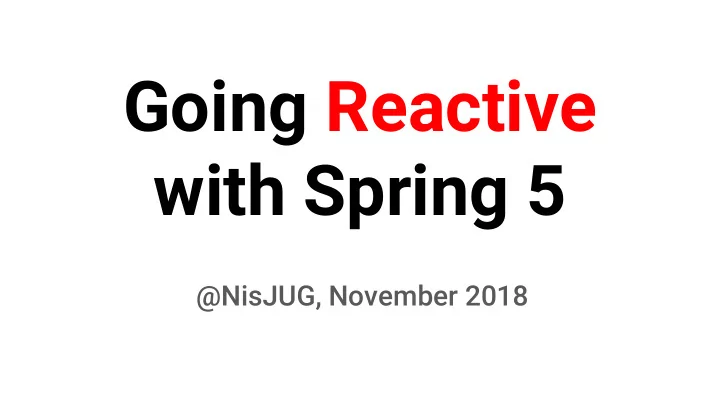

Going Reactive with Spring 5 @NisJUG, November 2018
Changing Requirements (then and now) 10 years ago Now Server nodes 10’s 1000’s Response times seconds milliseconds Maintenance downtimes hours none Data volume GBs TBs → PBs
Solution? EASY: Just spin up more threads!
Reactive Programming Asynchronous Non-blocking Functional-style code
When to Use Reactive? ● Handling networking issues, like latency or failures ● Scalability concerns ● Clients getting overwhelmed by the sent messages (handling backpressure) ● Highly concurrent operations
Reactive Manifesto www.reactivemanifesto.org
Reactive Streams Specification ● A spec based on Reactive Manifesto prescription Intention to scale vertically (within JVM), ● rather than horizontally (through clustering) ● A standard for async data stream processing Non-blocking flow control (backpressure) ● ● The Exceptions are first-class citizens Concept shift from imperative to declarative ● async composition of logic
Reactive Streams Specification public interface Publisher <T> { public void subscribe (Subscriber<? super T> s); } public interface Subscriber <T> { public void onSubscribe (Subscription s); public void onNext (T t); public void onError (Throwable t); public void onComplete (); } public interface Subscription { public void request (long n); public void cancel (); } public interface Processor <T, R> extends Subscriber<T>, Publisher<R> {}
How it works? Reactive Streams Implementations for Java: RxJava Project Reactor Akka Streams Ratpack Vert.x 3
Project Reactor: Mono<T> Publisher which emits 0 or 1 element (successfully or with an error)
Project Reactor: Flux<T> Publisher which emits 0 to N elements (successfully or with an error)
Various Reactor Operators
Various Reactor Operators
Various Reactor Operators
Java 8 Streams Example List<String> myList = Arrays.asList("a1", "a2", "b1", "c2", "c1"); myList .stream() .filter(s -> s.startsWith("c")) .map( String: :toUpperCase) .sorted() .forEach(System.out::println); // C1 // C2
Reactor Pipeline userService.getFavorites(userId) .timeout(Duration.ofMillis( 800 )) .onErrorResume(cacheService.cachedFavoritesFor(userId)) .flatMap( favoriteService ::getDetails) .switchIfEmpty(suggestionService.getSuggestions()) .take( 5 ) .publishOn(UiUtils.uiThreadScheduler()) .subscribe( uiList ::show, UiUtils ::errorPopup); ● Lazy evaluated ● Nothing is produced until there is a subscriber
Spring 5 Reactive Web
Annotation-based Programming Model @RestController public class PersonController { private final PersonRepository repository; public PersonController (PersonRepository repository) { this .repository = repository; } @GetMapping("/person") Flux<Person> list () { return this .repository.findAll(); } @GetMapping("/person/{id}") Mono<Person> findById (@PathVariable String id) { return this .repository.findOne(id); } }
Functional Programming Model - Handler public class PersonHandler { ... public Mono<ServerResponse> listPeople (ServerRequest request) { Flux<Person> people = repository.allPeople(); return ServerResponse.ok().contentType(APPLICATION_JSON) .body(people, Person.class); } public Mono<ServerResponse> createPerson (ServerRequest request) { Mono<Person> person = request.bodyToMono(Person.class); return ServerResponse.ok().build(repository.savePerson(person)); } }
Functional Programming Model - Router PersonRepository repository = ... PersonHandler handler = new PersonHandler(repository); RouterFunction<ServerResponse> personRoute = route(GET("/person/{id}" ).and(accept(APPLICATION_JSON)), handler: :getPerson) .andRoute(GET("/person").and(accept(APPLICATION_JSON)), handler: :listPeople) .andRoute(POST("/person").and(contentType(APPLICATION_JSON)), handler: :createPerson);
Functional Reactive Client WebClient client = WebClient. create("http://example.com" ); Mono<Account> account = client. get() .url("/accounts/{id}", 1L ) .accept(APPLICATION_JSON) .exchange(request) .then(response -> response. bodyToMono(Account.class));
Functional Reactive WebSocket Client WebSocketClient webSocketClient = new ReactorNettyWebSocketClient(); webSocketClient.execute( new URI("wss://echo.websocket.org" ), session -> session. send(input.map( session: :textMessage)) .thenMany(session .receive() .map( WebSocketMessage: :getPayloadAsText) .log()) .then())
Spring Data Reactive <dependency> <groupId> org.springframework.boot </groupId> <artifactId> spring-boot-starter-data-mongodb-reactive </artifactId> </dependency> public interface TweetRepository extends ReactiveCrudRepository<Tweet, String> { Flux<Tweet> findByTopic (String topic); }
WebFlux Spring Security @EnableWebFluxSecurity public class HelloWebfluxSecurityConfig { @Bean public MapReactiveUserDetailsService userDetailsService () { UserDetails user = User. withDefaultPasswordEncoder () .username("user") .password("user") .roles("USER") .build(); return new MapReactiveUserDetailsService (user); } }
Reactive Method Security @EnableWebFluxSecurity @EnableReactiveMethodSecurity public class SecurityConfig { @Bean public MapReactiveUserDetailsService userDetailsService() {...} } @Component public class HelloWorldMessageService { @PreAuthorize("hasRole('ADMIN')" ) public Mono<String> findMessage () { return Mono.just("Hello World!"); } }
DEMO https://github.com/drazen-nikolic/reactive-spring-5-demo
Questions?
References & Attributions Reactive Streams Specification for the JVM Reactive Spring - Josh Long, Mark Heckler Reactive Programming by Venkat Subramaniam What is Reactive Programming by Martin Oderski Reactive Streams: Handling Data-Flow the Reactive Way by Roland Kuhn What Are Reactive Streams in Java? by John Thompson Spring Boot Reactive Tutorial by Mohit Sinha Doing Reactive Programming with Spring 5 by Eugen Paraschiv
Where applicable... Be proactive, go Reactive! Spring will help you on this journey! Thank you
Recommend
More recommend